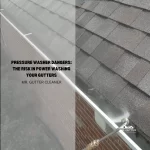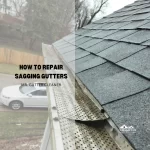Ice dams form when melted snow refreezes at the edge of a roof, creating a blockage that prevents subsequent meltwater from draining properly.
This phenomenon is not only a winter nuisance but can lead to significant damage to homes, including water intrusion, insulation degradation, and structural issues. Understanding and addressing ice dams is crucial for maintaining the integrity of a home.
Effective prevention focuses on improving attic insulation and ventilation to minimize uneven roof temperatures.
Additionally, regular maintenance, such as gutter cleaning and roof inspection, plays a vital role in reducing the risk of ice dam formation.
Homeowners facing this challenge can employ immediate measures to alleviate damage and seek professional services for safe removal and long-term solutions.
This approach ensures the home’s exterior is well-maintained, safeguarding against the potential hazards ice dams pose to both the structure and the occupants’ comfort.
What Are Ice Dams?
Ice dams are ridges of ice that form at the edge of a roof, preventing melting snow from draining off. Their formation stems from the uneven temperature distribution on the roof surface, where the higher sections warm enough to melt snow, while the colder edge causes this meltwater to refreeze.
How Do Ice Dams Form?
Ice dams develop when warm air in the attic causes the snow on the roof to melt. As the water flows down to the colder eaves, it refreezes, forming a dam. This process is exacerbated by poor attic insulation and inadequate ventilation, which allow heat to escape and warm the roof unevenly.
Why Are Ice Dams a Problem for Homeowners?
Ice dams can lead to serious problems for homeowners, including water leakage into the home. This can damage walls, ceilings, insulation, and other internal structures. The weight of ice dams can also strain gutters and roofing materials, potentially leading to costly repairs and maintenance issues. Additionally, the dampness associated with ice dams creates a favorable environment for mold and mildew growth, posing health risks to occupants.
Identifying Ice Dams
Recognizing ice dams early is crucial for preventing extensive damage to your home. Homeowners can spot these formations by observing specific signs and understanding the potential damage they can cause.
Common Signs of Ice Dams
The most noticeable signs of ice dams include icicles forming along the edge of the roof, though not all icicles indicate a dam. Other indicators are ice or water on the exterior walls, ice forming on the soffit, or ice in the gutters and downspouts. Inside the house, water stains or moisture in the attic or along the ceiling and walls near the roofline suggest ice dam formation.
Potential Damage Caused by Ice Dams
Ice dams can inflict significant damage on a home. They can lift shingles, causing leaks that lead to interior water damage. Over time, this moisture can rot the roof decking, damage insulation, and lead to mold and mildew growth. Additionally, the weight of ice dams can strain gutters and downspouts, potentially causing them to detach from the house. Understanding these risks emphasizes the importance of timely identification and intervention to protect the home’s structure and indoor air quality.
Preventing Ice Dams
Preventing ice dams is essential for safeguarding the structural integrity of your home and avoiding costly repairs. By focusing on insulation, ventilation, and sealing air leaks, homeowners can significantly reduce the risk of ice dam formation.
Improving Attic Insulation
Enhancing attic insulation is a key step in preventing ice dams.
Insulation keeps heat from escaping from the living spaces below into the attic, maintaining a more uniform roof temperature and preventing the snow on the roof from melting and refreezing at the eaves.
Homeowners should aim for an insulation R-value that meets or exceeds local building codes to effectively inhibit heat transfer.
Enhancing Ventilation in the Attic
Proper attic ventilation ensures that any heat that does reach the attic can escape, further helping to maintain an even roof temperature. Ventilation systems, including soffit, ridge, and gable vents, work together to circulate cold air under the roof and dissipate any accumulated heat.
This airflow prevents the under-roof from becoming warm enough to melt snow, which is a direct cause of ice dam formation.
Sealing Air Leaks to Prevent Warm Air Escape
Sealing air leaks between the living space and the attic is critical to ice dam prevention. Warm air that escapes into the attic contributes to snowmelt on the roof. By using caulk or spray foam to seal leaks around light fixtures, chimneys, and other attic penetrations, homeowners can further reduce the chances of ice dam development. This step, coupled with insulation and ventilation improvements, forms a comprehensive approach to preventing ice dams, protecting the home from potential water damage and contributing to overall energy efficiency.
Safe Removal of Ice Dams
Removing ice dams safely is critical to prevent damage to your home and to ensure personal safety. Homeowners should take immediate action upon noticing signs of ice dam formation, and in some cases, professional assistance may be required.
Immediate Steps to Take When You Notice an Ice Dam
When you detect an ice dam, the first step is to remove snow from the roof, which can alleviate the immediate weight and reduce further melting. Use a roof rake with a long handle to safely pull snow off the roof from the ground, being careful not to damage the roofing materials. Avoid using sharp tools that could puncture the shingles or roof. For ice that’s already formed, applying calcium chloride ice melter to the dam can help break it down. Do not use rock salt, as it can damage your roof and gutters.
Professional Ice Dam Removal Services
For ice dams that are large, extensive, or situated on complex roofing, professional removal services are recommended. Professionals have the necessary equipment, such as steamers, that gently remove ice without harming the roofing materials. Hiring experts not only ensures safe removal but also protects homeowners from the risks associated with climbing on icy roofs.
Do’s and Don’ts of Ice Dam Removal
Do’s:
- Do use a roof rake for snow removal to prevent ice dam formation.
- Do apply calcium chloride ice melt to break down the ice dam.
- Do ensure gutters and downspouts are clear to allow melted ice to flow away from the house.
Don’ts:
- Don’t attempt to chip away at the ice dam with sharp objects, as this can damage your roof.
- Don’t use rock salt, which can corrode gutters and downspouts and harm plant life.
- Don’t climb onto the roof in icy conditions; this poses a significant safety risk.
Adhering to these guidelines can help homeowners manage ice dams effectively while minimizing the risk of damage to the property and ensuring personal safety.
Long-Term Solutions for Ice Dam Prevention
Implementing long-term solutions is key to preventing ice dam formation effectively. These measures not only address the immediate concern but also contribute to the overall energy efficiency and structural integrity of the home.
Installing Heated Cables
Heated cables, when properly installed along the roof’s edge and in gutters and downspouts, provide a path for meltwater to flow freely, preventing ice buildup.
It’s a preventive measure that homeowners can consider, especially in areas prone to heavy snowfall.
These cables are designed to be self-regulating, ensuring they heat up where necessary and remain off otherwise, making them an energy-efficient option.
Upgrading Your Roofing System
Upgrading the roofing system can significantly impact ice dam prevention.
Opting for materials and designs that improve roof ventilation and insulation can ensure a more uniform roof temperature.
Metal roofs, for example, shed snow and ice more effectively than traditional shingle roofs, reducing the risk of ice dam formation.
Regular Roof and Gutter Maintenance
Routine maintenance of the roof and gutters is crucial in preventing ice dams. Keeping gutters clean and free of debris allows meltwater to flow away from the house, reducing the chance of ice formation. Additionally, inspecting the roof for damages such as missing shingles or vulnerabilities in the roofing membrane before the winter season can prevent water from seeping into the home, which could lead to ice dam formation.
Insurance and Ice Dams
Understanding insurance coverage for ice dam damage is essential for homeowners, as it helps in mitigating financial risks associated with repairs. Home insurance policies typically cover damage caused by ice dams, but it’s crucial to know the specifics of your coverage and how to navigate the claims process.
Understanding Your Policy Coverage
Most homeowner’s insurance policies cover damage resulting from ice dams under the peril of water damage. However, the extent of coverage can vary. It’s important to review your policy to understand what is and isn’t covered. Some policies may cover the cost of removing the ice dam and repairing any water damage, while others may only cover the damage caused by the ice dam, not the removal of the ice dam itself. Preventative measures taken before damage occurs, such as installing heated cables or improving insulation, are typically not covered.
Filing a Claim for Ice Dam Damage
When filing a claim for ice dam damage, document the damage thoroughly with photos and detailed descriptions. Contact your insurance company as soon as possible to report the damage. An adjuster will likely inspect your home to assess the damage and determine your claim’s validity. Keep records of all communications with your insurance company, including dates, names, and summaries of conversations. Additionally, retain receipts for any emergency repairs made to prevent further damage, as these costs may be reimbursable under your policy.
Preventive Measures and Insurance Premiums
Taking proactive steps to prevent ice dams can not only protect your home but also potentially lower your insurance premiums. Some insurance companies offer discounts for homes that implement measures to prevent ice dams, such as improved attic insulation and ventilation. Contact your insurance provider to inquire about any discounts for which you may be eligible. Demonstrating a commitment to preventing ice dams shows your insurer that you are taking active steps to mitigate risks, which can positively influence your policy terms and premiums.
Frequently Asked Questions About Ice Dams
Addressing common queries can further enhance homeowners’ understanding and management of ice dams. This section aims to answer prevalent questions, providing concise, factual information to equip homeowners with the knowledge to prevent and deal with ice dams effectively.
Can Ice Dams Cause Permanent Damage to My Home?
Yes, ice dams can cause permanent damage if not addressed promptly. They can lead to water infiltration under shingles, damaging roofs, insulation, and interior ceilings and walls. Persistent issues may result in mold growth and structural deterioration, necessitating significant repairs.
How Often Should I Inspect My Roof for Ice Dam Risks?
Inspect your roof at least twice a year: in the fall before snowfall begins and in the spring as the snow melts. These inspections can identify potential vulnerabilities that could lead to ice dam formation, such as damaged shingles, inadequate insulation, or poor ventilation.
Are There Any DIY Solutions for Ice Dam Prevention?
Several DIY solutions can help prevent ice dams, including improving attic insulation and ventilation, sealing air leaks, and installing heated cables along the roof’s edge. Regularly clearing snow from the roof using a roof rake and ensuring gutters and downspouts are clean and clear can also prevent ice dams from forming. However, for extensive issues or if you’re uncomfortable performing these tasks, consulting a professional is recommended.


